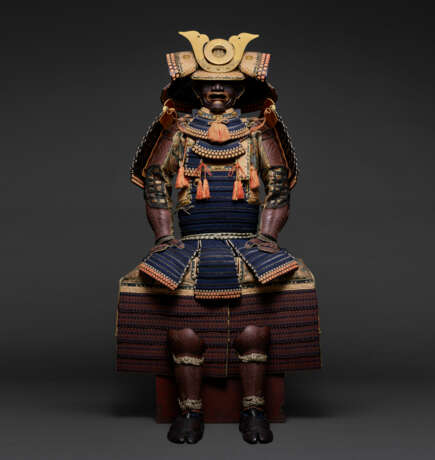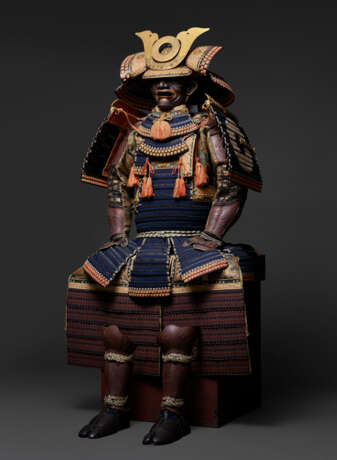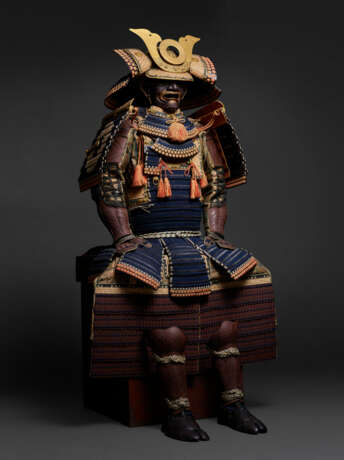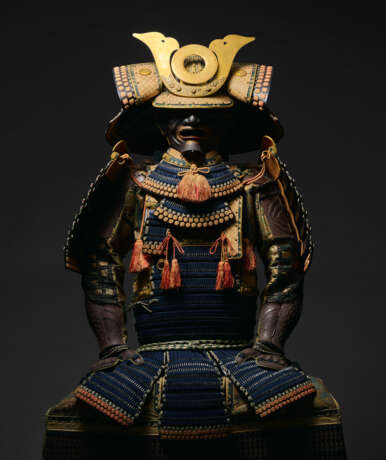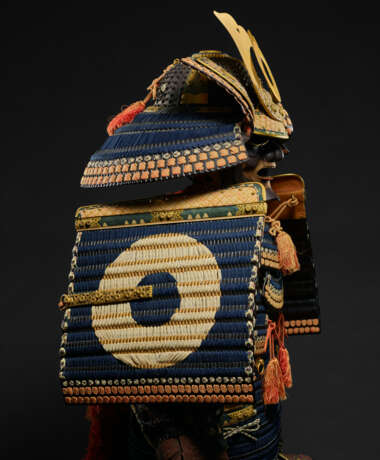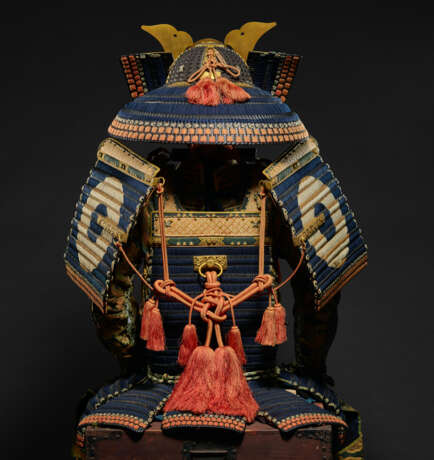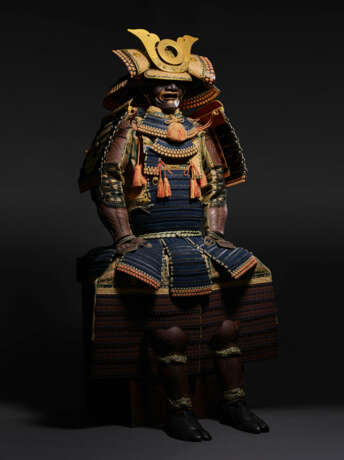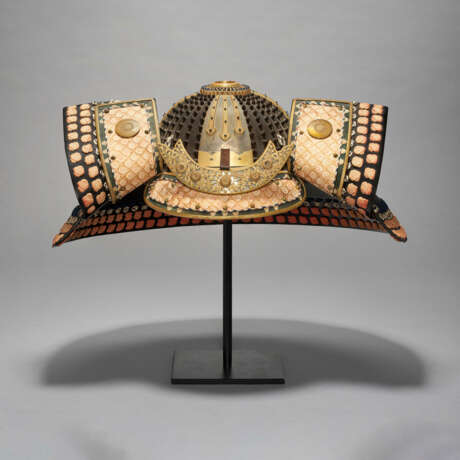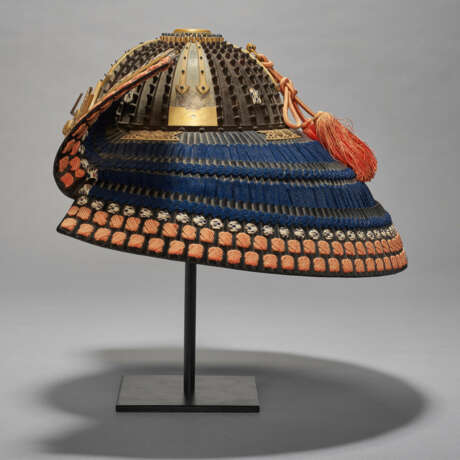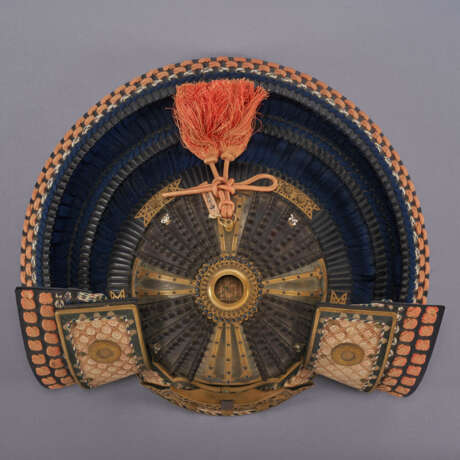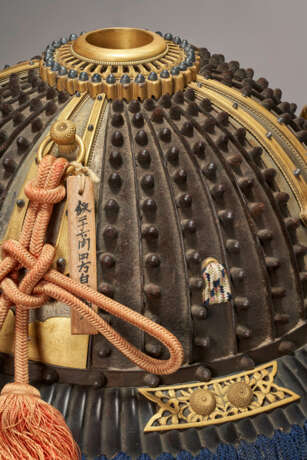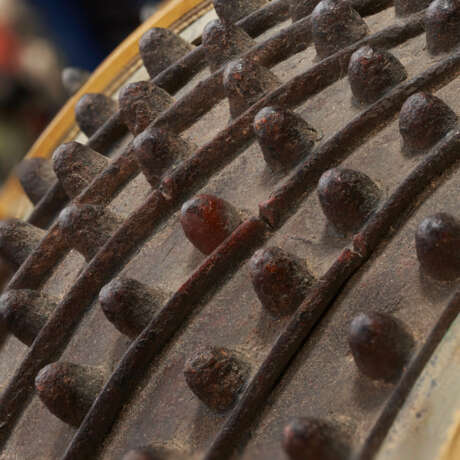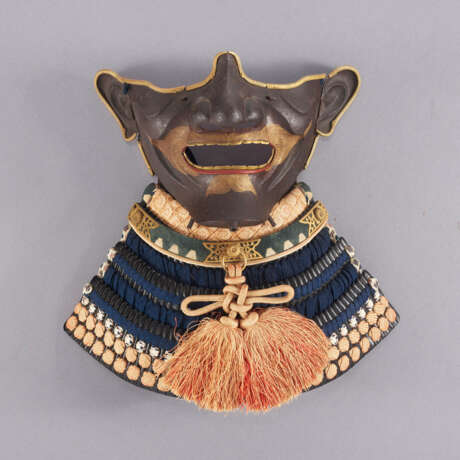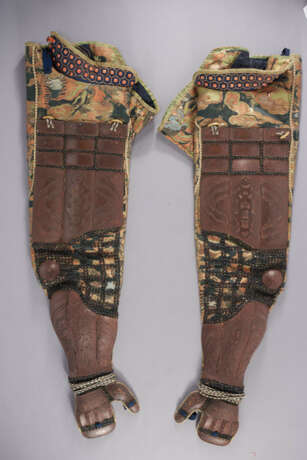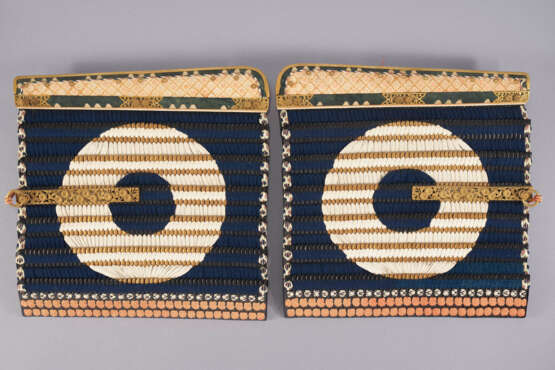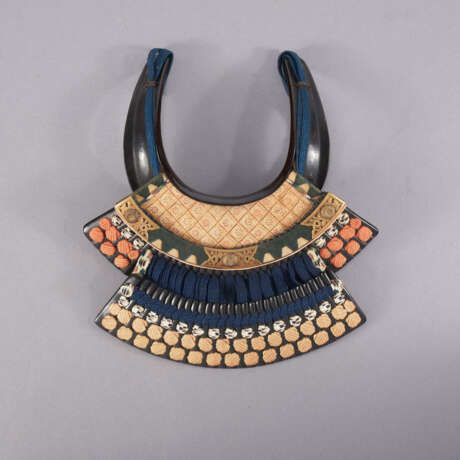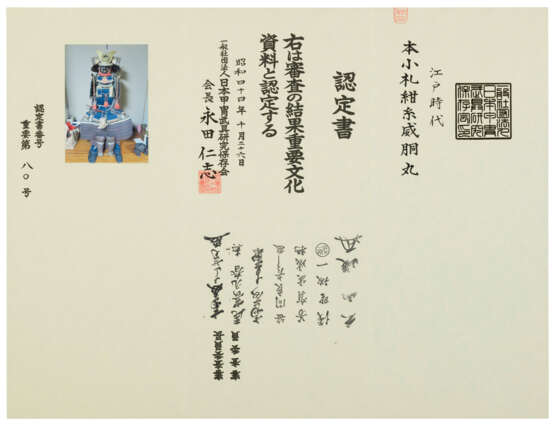ID 813474
Лот 112 | A BLUE-LACED HONKOZANE DAIMYO DOMARU GUSOKU (ARMOR)
Оценочная стоимость
$ 180 000 – 250 000
EDO PERIOD (18TH CENTURY), HELMET BOWL: KAMAKURA PERIOD (13-14TH CENTURY)
Helmet [kabuto]:
The twenty six-plate Kamakura period hoshi bachi kabuto (“star bowl,” alluding to the protruding rivets) of rounded form, with elaborate gilt and copper hachimanza (decorative fixture at the central aperture) of four-tier, with gilt shinodare (four sets of pendant arrow shaped decorative pieces) set on silver plates, the bowl with four hibiki-no-ana (small holes adjacent to protruding rivets with vestiges of textile), with gilt kuwagata-dai (fixture for two gilt horns) pierced with scrolling chrysanthemums on silver plate and applied with three gilt chrysanthemum shaped rivets, the maedate (fore-crest) of a large gilt jyanome-mon (family crest of snake eye), gilt fukurin (edging) engraved with scrolling, the interior of the helmet bowl lacquered in gold
Neck guard [shikoro]:
The wide and gently curving kasa-jikoro ("straw hat," or "umbrella"-shape neck guard) of blue lacing kebikiodoshi (close-lacing) of lacquered iron shittsukezane (plate in semblance of individual lamellae) with orange hishi-nui (decorative cross-knots) around the lower two tiers, the large double fukigaeshi (turn-backs) clad with leather with gilt jyanome-mon (family crest of snake eye)
Face mask [menpo]:
The hammered russet iron ressei-style menpo (face mask) with detachable nose and large ears, the moustache finely decorated in gold, applied with fine gilt fukurin (edging) of a nanako ('fish-roe') ground, the mouth wide open with red lips and gilded teeth, red lacquered interior, applied with the ase-nagashi (sweat hole) and odayori nokugi (cord hooks) under the chin, with three-tier yodarekake (bib) of lacquered iron shittsukezane (plate in semblance of individual lamellae) with agemaki-no-kan (ring to hold a decorative bow), the nodowa (gorget throat protector ) of two-tiers of honkozane
Cuirass [do]:
The black lacquered iron honkozane domaru (cuirass) of blue lacing kebikiodoshi (close-lacing), applied with sendan no ita and kyubi no ita with gilt jyanome-mon (family crest of snake eye), the sendanno ita and kyubi no ita clad with leather, the large fixture of agemaki-no-kan (ring to hold a decorative bow) on reverse side pierced with scrolling chrysanthemums, the eight kusazuri (skirt) in five tiers of honkozane of lacquered iron plates
Sleeves and shoulder guards [kote and sode]:
The russet iron sanbon tsutsugote (sleeves) with hinges finely decorated with clouds, wave, two-sided sword and hanabishi (stylized flower), O-sode (large shoulder guards) of gold and black lacquered honkozane with blue and white lacing designed with large jyanome-mon (family crest of snake eye)
Thigh protector and lower leg guards [haidate and sune-ate]:
The lacquered iron kawara haidate (thigh protectors with iron plates in the form of roof tiles), the russet iron sanbon tsutsusuneate (lower leg guards) with stylized flower hinges, black lacquered leather kogake (foot guards)
Accessories:
The saihai (paper signal baton), a wood armor storage box
Accompanied by a certificate of registration as a Juyo bunka shiryo (Important cultural material) no. 80 issued by the Nihon Katchu Bugu Kenkyu Hozon Kai (Japanese Armor Preservation Society), dated 1969.10.26
Provenance
Kato Yasutake (1745-1768), the seventh generation daimyo of Ozu clan, Ehime Prefecture
Literature
Kacchu bugu juyo bunka shiryo zuroku (Catalogue of important cultural materials of armor and arms), vol.1 (Tokyo: Nihon kacchu bugu kenkyu hozon kai, 2020). pp.176-177
Special Notice
Prospective purchasers are advised that several countries prohibit the importation of property containing materials from endangered species, including but not limited to coral, ivory and tortoiseshell. Accordingly, prospective purchasers should familiarize themselves with relevant customs regulations prior to bidding if they intend to import this lot into another country.
| Историческая эпоха: | Период Эдо, Период Камакура |
|---|---|
| Место происхождения: | Восточная Азия, Япония |
| Категория аукционного дома: | Доспехи |
| Историческая эпоха: | Период Эдо, Период Камакура |
|---|---|
| Место происхождения: | Восточная Азия, Япония |
| Категория аукционного дома: | Доспехи |
| Адрес торгов |
CHRISTIE'S 20 Rockefeller Plaza 10020 New York США | ||||||||||||||
|---|---|---|---|---|---|---|---|---|---|---|---|---|---|---|---|
| Предосмотр |
| ||||||||||||||
| Телефон | +1 212 636 2000 | ||||||||||||||
| Факс | +1 212 636 4930 | ||||||||||||||
| Условия использования | Условия использования | ||||||||||||||
| Транспортировка |
Почтовая служба Курьерская служба Самовывоз | ||||||||||||||
| Способы оплаты |
Банковский перевод | ||||||||||||||
| Часы работы | Часы работы
|
